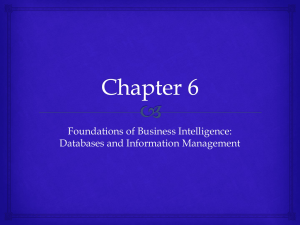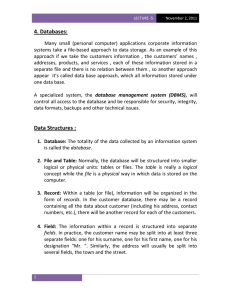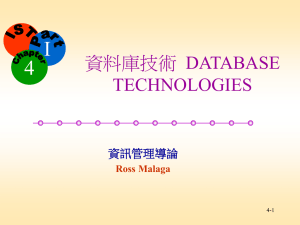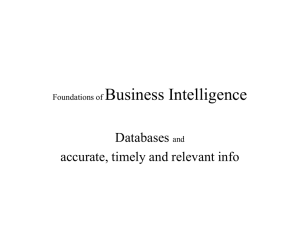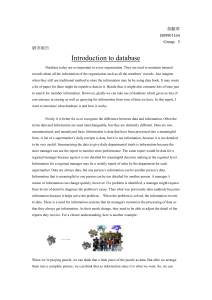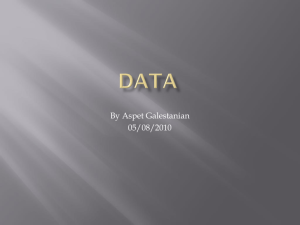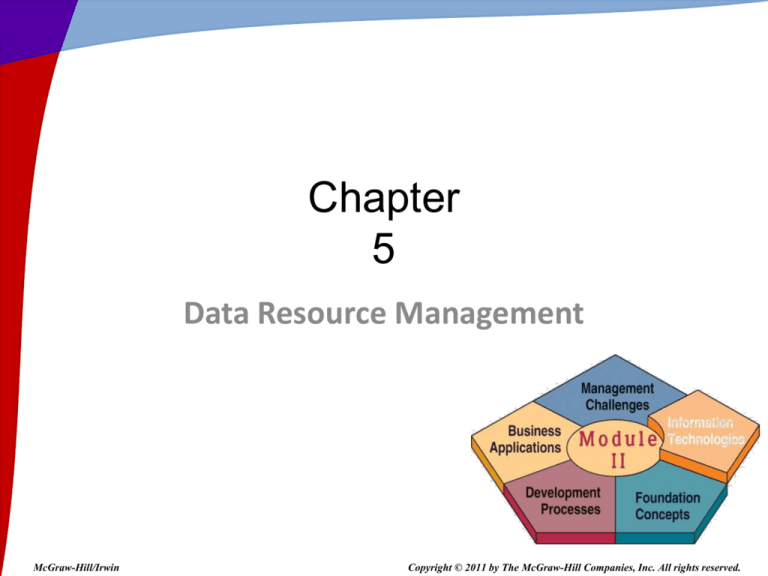
Chapter
5
Data Resource Management
McGraw-Hill/Irwin
Copyright © 2011 by The McGraw-Hill Companies, Inc. All rights reserved.
Learning Objectives
• Explain the business value of implementing
data resource management processes and
technologies in an organization.
• Outline the advantages of a database
management approach to managing the data
resources of a business, compared to a file
processing approach.
• Explain how database management software
helps business professionals and supports
the operations and management of a
business.
5-2
Learning Objectives
• Provide examples to illustrate the
following concepts
– Major types of databases
– Data warehouses and data mining
– Logical data elements
– Fundamental database structures
– Database development
5-3
RWC 1: Data-Driven Crime Fighting
• Information-led policing
– Era began in 1990 in New York City
• Crime mapping
– Incident reporting combined with GIS
• Predictive policing
– Predict where and when crimes will occur
• Pertinent questions
– How long is data kept?
– With whom is it shared?
5-4
Logical Data Elements
5-5
Logical Data Elements
• File or table
–
–
–
–
–
A group of related records
Master file
Transaction file
History file
Archival file
• Database
– An integrated collection of logically related
data elements
• World’s largest database?
5-6
Electric Utility Database
5-7
Database Structures
• Common database structures…
– Hierarchical
– Network
– Relational
– Object-oriented
– Multi-dimensional
5-8
Database Structures
Network Structure
5-9
Relational Structure
• Most widely used structure
– Data elements are stored in tables
– Row represents a record; column is a field
– Can relate data in one file with data in another,
if both files share a common data element
5-10
Relational Operations
• Select
– Create a subset of records that meet a stated
criterion
• Example: employees earning more than $30,000
• Join
– Combine two or more tables temporarily
– Looks like one big table
• Project
– Create a subset of columns in a table
5-11
Multidimensional Model
5-12
Object-Oriented Structure
5-13
Evaluation of Database Structures
• Hierarchical
– Works for structured, routine transactions
– Can’t handle many-to-many relationships
• Network
– More flexible than hierarchical
– Unable to handle ad hoc requests
• Relational
– Easily responds to ad hoc requests
– Easier to work with and maintain
– Not as efficient/quick as hierarchical or network
5-14
Database Development
• Database Administrator (DBA)
– Enterprise database development
– Improves integrity and security
– Data Definition Language (DDL)
• Data contents, relationships, and structure
– Specifications
• Data dictionary
• Metadata repository
5-15
Data Dictionary
• A data dictionary
– Contains data about data (metadata)
– Specialized software manages data definitions
• Contains information on…
–
–
–
–
–
Names, types and descriptions of data
Relationships
Requirements for access and use
Maintenance
Security
5-16
Data Planning and Database Design
• Database development is top-down process
– Develop an enterprise model
– Define the information needs of end users
– Identify the key data elements
5-17
Database Development
5-18
Entity Relationship Diagram
5-19
Logical and Physical Database Views
5-20
Data Resource Management
• Managerial activity
– Uses data management, data warehousing,
and other IS technologies
– Manages data for business stakeholders
5-21
RWC 2: Medical IT Is Getting Personal
• Duke University Health System
– Personalized approach to treating patients
– Analytics engine on top of clinical repository
– Decision support tools pick best treatment
• Beth Israel Deaconess Medical Center
– Catch details that elude a doctor
– Tests personalized for patient
• National Cancer Institute
– Blend data warehouse with Web collection tools
– More patient data for research
5-22
Types of Databases
5-23
Components of Web-Based System
5-24
Data Warehouse Components
5-25
Data Warehouse and Data Marts
5-26
Data Mining
5-27
Traditional File Processing
5-28
Database Management Approach
5-29
Common DBMS Software Components
Better Graphic?
5-30
DBMS Major Functions
5-31
Database Interrogation
• SQL Queries
– Structured Query Language
– International standards
– In many DBMS packages
– Query form is
SELECT…FROM…WHERE…
5-32
Database Interrogation
• Boolean Logic
– Developed by George Boole
– Mid-1800s
– Used to refine searches
– Three logical operators: AND, OR, NOT
• Example
– Cats OR felines AND NOT dogs OR Broadway
5-33
Database Maintenance
• Accomplished by
– Transaction processing systems
– Utilities and other applications, supported by
DBMS
– Records new business transactions
– Updating and correcting data
• Customer addresses
5-34
Application Development
• DBMS tools
– 4GL programming language
– Built-in software development tools
– Data manipulation language (DML) statements
• Eliminate conventional programming
• Applications
– Data entry screens
– Forms
– Reports
– Web pages
5-35
RWC 3: Mergers Go More Smoothly
• IT issues make or break mergers
• Data Center feels impact
• Knowledge lost if “acquired” IT people let go
• Documentation necessary
• Companies need to know what goes on in
their data centers
5-36
RWC 4: Data Mining
• Aggregate data for better decisions
• Applebee’s
– Uses back-of-house data to analyze food
preparation
– Combined with front-of-house data
• Determine time spent with customer
• What is selling / what to order / what to promote
• Travelocity
– 600,000 comments in e-mails and call notes
– Set up mining system to extract meaning
• VistaPrint
– Analyzes customer online behavior
5-37


